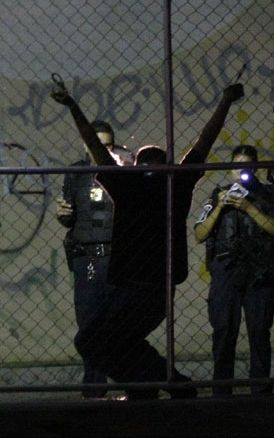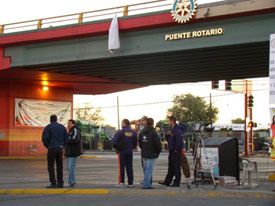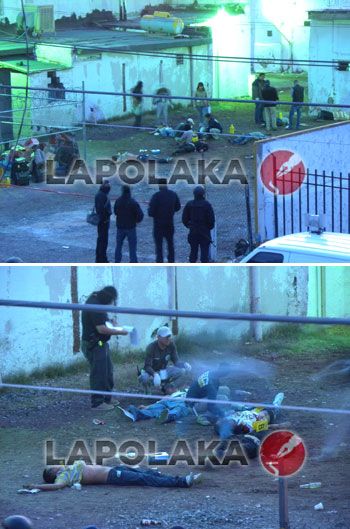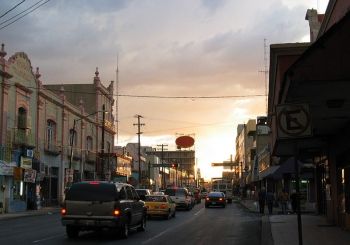
Publisher:
Bonnie King
CONTACT:
Newsroom@Salem-news.com
Advertising:
Adsales@Salem-news.com

~Truth~
~Justice~
~Peace~
TJP
Apr-28-2010 19:09

 TweetFollow @OregonNews
TweetFollow @OregonNews
Special Feature: Solidarity with a Besieged Sister City
Kent Paterson for Salem-News.comCiudad Juarez has an estimated population of 1-1.3 million people.
 Photos from various Mexican newspapers covering the deadly drug-based violence in Ciudad, Juarez. |
(LAS CRUCES, N.M.) - (Editor’s note: The following story was made possible in part by a grant from the McCune Charitable Foundation for ongoing coverage of the southern New Mexico borderland.)
New Mexico State University criminal justice Professor Cynthia Bejarano has long heard the painful stories and seen the sorrowful faces from the violence raging away in Ciudad Juarez just forty-five minutes south of her Las Cruces campus. Lately, students have had loved ones attacked and normal back-and-forth family visitations disrupted in their binational community.
And academic relationships between Mexican and US scholars have suffered, as schools like New Mexico State warn their staff and students about visiting dangerous areas in Mexico.
So when colleagues at the Autonomous University of Ciudad Juarez (UACJ) proposed publicly airing their deep concerns in neighboring New Mexico, Bejarano and fellow scholars were quick to jump in support of a sister city. “What happens there also affects us on this side of the border,” Bejarano told Frontera NorteSur.

“What we’re afraid of is that this is breeding a sense of normalization, of normalized violence, that people understand as part of the everyday routine, which is really worrisome and disconcerting.”
Together with the UACJ, New Mexico State’s Department of Criminal Justice and other divisions of the university sponsored a recent public forum in which sometimes overlooked dimensions of the much-publicized violence in Ciudad Juarez were analyzed and discussed. More than 100 people attended the event, including a large number of individuals who indicated they had personal ties to the Mexican border city.
UACJ researchers Hector Padilla and Hugo Almada examined the socio-psychological ramifications of a violence Padilla said was becoming a “socializing” factor in the development of the future generation. Children and adolescents, the political scientist said, are first introduced to a pervasive violence as spectators, graduate to serving as its executioners and finally become its victims.
The more than two-year-old “narco war” has left an estimated 10,000 children orphaned and 40,000 relatives of victims impacted in one way or another, sociologist Almada said, as well as a large number of people who have suffered extortion and kidnapping.
Ciudad Juarez has an estimated population of 1-1.3 million people.
Clusters of depression, anxiety and panic attacks are spreading among the population, Almada warned. “This is even leading to physical ailments in the people,” he added.
As if to underscore the chilling points made by the two scholars, new episodes of violence have riveted Ciudad Juarez in recent days, according to local media reports. For instance, on April 22, the same day of the Las Cruces forum, a man was shot to death outside Ciudad Juarez’s Luis Arnoldo Gutierrez School right as the elementary schoolchildren were preparing for morning recess.
The next day, several federal police officers, a female municipal cop and a 17-year-old youth were slaughtered in a well-organized ambush. On April 27, 13 people were reported murdered. The morning of April 28 started on a horrific note when armed gunmen mowed down 8 people outside a bar near downtown Juarez and close to a place where federal police officers reportedly are lodged.

According to New Mexico State researcher Molly Molloy, more than 800 people have been murdered in Ciudad Juarez during 2010 so far. The current pace of killings is only slightly less than the murder rate for 2009, when about 2,600 victims-a record number-were registered.
Speaking in Las Cruces, Gustavo de la Rosa Hickerson, investigator for the official Chihuahua State Human Rights Commission (CEDH) analyzed the evolution of the violence in Ciudad Juarez since 2008, when a war for control of the city broke out between the Juarez and Sinaloa drug cartels.
Concurring with other panelists, de la Rosa defined the war as one that was imposed on the people of the city. The state official said the anti-drug Merida Initiative negotiated between the Bush and Calderon administrations assured the Mexican army a central role, which soon became controversial when the violence actually increased after troops were officially deployed to halt the carnage.
“Behind the army or together with the army, the Sinaloa cartel comes,” de la Rosa told his audience. “We don’t know or can’t affirm if they came to an agreement, but that’s the reality we are suffering,” he said.

“It is a war in which three armies participate-the army of the Juarez cartel, the army of the Sinaloa cartel and the Mexican army,” de la Rosa asserted. “The people of Juarez aren’t going to gain anything if the Juarez cartel or the Sinaloa cartel falls.. I can assure you that the salaries of the people of Juarez won’t go up even a dollar if one of the two cartels falls.”
According to De la Rosa, the violence in his city has gone through three distinct stages, with the first one devouring well-off people driving nice cars and sporting fancy clothes. “It was obvious that the dead people and the executioners were people linked to the cartels, cartel professionals.”
In the second stage, he said, a large number of young people, presumed small-time drug dealers or members of the “reserve army” of the rival cartel, were slaughtered by armed commandos. In the third phase, he continued, a “terrible massacre” ensued of family members of rivals. De la Rosa called a group of murder victims consisting of an estimated 300-400 drug addicts “invisible beings” whose deaths didn’t “serve anybody.” Noting that family members of the slain addicts did not even bother to press cases, de la Rosa concluded they were “invisible” even to their own relatives.
Of more than 5,000 murders in Ciudad Juarez since 2008, less than 100 have been prosecuted, de la Rosa affirmed.
According to the human rights investigator, other examples of the mayhem during the last two years include 30,000 extortions and 1,000 kidnappings. Prior to 2008, kidnapping-for-ransom was not a common crime in Ciudad Juarez, unlike other parts of the Mexican Republic, including the states of Mexico, Morelos and Guerrero, where former or current members of law enforcement agencies and the military often have been implicated in professional kidnapping rings.
A former director of the Ciudad Juarez prison and longtime social activist, de la Rosa made international news when he was detained for six days in El Paso last fall by US Immigration and Customs Enforcement after telling US border guards he was fearful for his safety.
In the days leading up to the incident, de la Rosa had reported receiving threats, possibly linked to his probes of human rights abuses implicating Mexican soldiers, and one of his bodyguards had been murdered.
The CEDH, de la Rosa said, has investigated more than 22 Ciudad Juarez cases against the military that involve 30 disappeared or murdered persons. Overall, more than 170 cases have gone to military prosecutors, he said, but not a single soldier has faced a judge. “The soldiers have 100 percent guarantees of impunity,” de la Rosa contended.
De la Rosa credited public pressure for forcing the withdrawal of the army from regular policing duties in Ciudad Juarez. The soldiers were replaced by beefed-up contingents from the Federal Police earlier this month. This month’s indictments of 17 federal officers on extortion and theft charges was a positive sign of possible change, de la Rosa opined.
The Las Cruces forum participants proposed structural economic changes, human rights campaigns, non-violent problem-solving, ending impunity, and local community development as possible answers to the Ciudad Juarez crisis.
Representing the Maria Sagrario Foundation of Ciudad Juarez, Paula Flores presented a slide show that depicted the numerous programs launched by the grassroots, not-for-profit organization in the working-class Lomas de Poleo neighborhood. The foundation is named after Flores’ daughter, Maria Sagrario Gonzalez, who was brutally murdered at the age of 17 in 1998. “My Sagrario hasn’t died,” Flores said. “She lives on, she continues living in the people.”

Operating on a shoe-string budget, the foundation offers arts-and-crafts workshops, sewing classes, income-producing, and cultural programs for both young people and adults. Plans are afoot for museum excursions, music appreciation classes and literary workshops, Flores said.
In an interview with Frontera NorteSur, Flores extolled a project with 25-30 youths, so-called “Ni, Nis” who do not attend school or hold regular employment, as an especially promising endeavor.
“You can say that we are rescuing them from forming gangs,” Flores said. “We see that they have a lot of energy and we want this energy applied to something more positive so they can contribute to ending this violence.”
Flores, however, was critical of the official “Todos Somos Juarez” program launched by Mexico’s federal government earlier this year to tackle the root causes of the Ciudad Juarez violence. Although Flores and her group are well-known, they were not invited to join the working groups set up to advise the program, she said.
“I think that in order to say, ‘We are all Juarez,’ they should begin with the most humble, where the problem and necessity really is at in order to eliminate all of this.”
New Mexico scholar and activist Bejarano said the Las Cruces forum was but one step in a process of educating the US public about the community “fightback” in Ciudad Juarez, sharpening the binational dialogue and building cross-border linkages between people .
“I think one thing as Americans we really need to be cognizant of is that it isn’t a coincidence that this violence is happening along the border,” Bejarano said. “And we haven’t had serious conversations about the drug trafficking coming into the US, the drug consumption and some of the other vices that seem to exist here in the US that are sort of swept under the rug.”
===============================================
Special thanks to Kent Paterson and Frontera NorteSur (FNS): on-line, U.S.-Mexico border news Center for Latin American and Border Studies New Mexico State University Las Cruces, New Mexico
Articles for April 27, 2010 | Articles for April 28, 2010 | Articles for April 29, 2010
Quick Links
DINING
Willamette UniversityGoudy Commons Cafe
Dine on the Queen
Willamette Queen Sternwheeler
MUST SEE SALEM
Oregon Capitol ToursCapitol History Gateway
Willamette River Ride
Willamette Queen Sternwheeler
Historic Home Tours:
Deepwood Museum
The Bush House
Gaiety Hollow Garden
AUCTIONS - APPRAISALS
Auction Masters & AppraisalsCONSTRUCTION SERVICES
Roofing and ContractingSheridan, Ore.
ONLINE SHOPPING
Special Occasion DressesAdvertise with Salem-News
Contact:AdSales@Salem-News.com


googlec507860f6901db00.html


Terms of Service | Privacy Policy
All comments and messages are approved by people and self promotional links or unacceptable comments are denied.
[Return to Top]
©2025 Salem-News.com. All opinions expressed in this article are those of the author and do not necessarily reflect those of Salem-News.com.